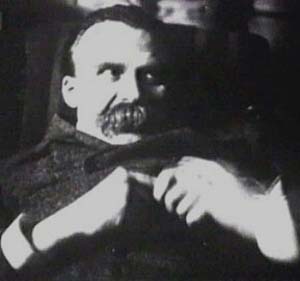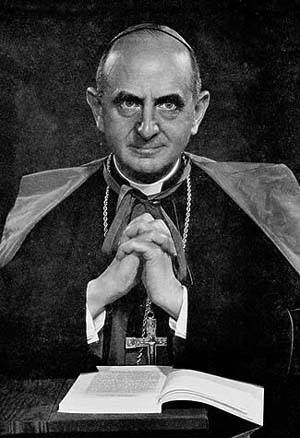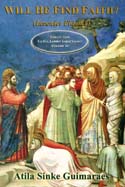 |
Consequences of Vatican II
Bad Creations of the Conciliar Popes
Lyle J. Arnold, Jr.
Hamlet's question "To be, or not to be" (1), should always be given serious thought by someone about to create something. Is existence or non-existence the best? There's a bill to pay if you bring something bad into existence. A story about Friedrich Nietzsche will make clear the danger.
Nietzsche created Zarathustra to solve the problem of modernity, which was besieging humanity. Modernity is a bad thing, but in Zarathustra's twisted mind it was caused, not by liberal people, but by the theory of God's death. Immersed in Atheism, he expressed astonishment that some people still believed. Upon seeing a saint in the forest, who was making hymns to God, singing his songs, laughing, weeping and praising Him, Zarathustra couldn't contain himself:
"Could it be possible! This old saint in the forest hath not yet heard of it, that God is dead! " (2)

Nietzsche - His madness increased as he approached death |
Zarathustra is the Persian name for Zoroaster, the founder of Zoroastrianism, a dualist cult. Dualism accepts the existence of two equal principles at the origin of good and evil, one fighting against the other. Hence Zoroaster was "the first to consider the fight of good and evil the very wheel in the machinery of things" (3). Yet Zarathustra was against dualism. As a Nietzsche scholar explains:
"For Zarathustra there is only one world, and that world is essentially physical. Zarathustra is a materialist monist, in other words, he rejects dualism in its philosophical as well as in its religious forms. Plato, Descartes, and Kant are as unacceptable to him as Christianity or any other metaphysical religion. `Be faithful to the earth!' he admonishes his followers"(4).
The nature of these two bad creations is clear. But the question looms as to how the anti-dualist Zarathustra became the spokesman to preach salvation for mankind. Why choose the name of a dualist? The answer is as follows:
"Nietzsche is clearly portraying a 'new' or 'different' Zarathustra, one who turns traditional morality on its head. He goes on to characterize 'what the name of Zarathustra means in my mouth, the mouth of the first immoralist'"(5).
To use a cliché, Nietzsche introduced something new under the sun. His act was a creative act. He brought something into existence that didn't heretofore exist. In his book on Zarathustra, James Luchte explains:
"Nietzsche chose Zarathustra, in one instance, since, as a historical and mythological figure, the latter is attributed with the original articulation of the severance of good and evil. For even though we can retrospectively witness the ossification and nihility of his progeny, his act was that of a creator - even if only a creator of nothingness" (6).
Because "traditional morality" was turned "on its head" by Vatican II, it is hard to resist speculation as to whether or not the conciliar Popes were consciously, or unconsciously, following Nietzsche. They, too, created something new under the sun. John XXIII was a creator. He created his own plan of salvation for mankind, by opening the windows of the Church and letting the world in. He checkmated Our Lady's plan, and made as of nothing her instruction for peace.

Card. Montini, later Paul VI |
Paul VI was a creator. He used Annibale Bugnini, an arch-enemy of the Church, to create an evil liturgy that overthrew both the Mass and Tradition (7). How could a liturgy created by an arch-enemy of the Church be anything but evil? The fruits of Vatican II and the Novus Ordo are there for all to see. Lex orandi, lex credendi. The law for praying sets the law for believing. As few as 15% of Catholics still believe in the Real Presence (8). The Faith of legions was turned into nothingness by the creations of John and Paul.
John Paul II, adopting the names of both his predecessors, was not to be outdone as a creator. Just as Nietzsche's creation performed "the severance of good and evil," giving a new unity, at Assisi John Paul created a new unity by the severance of differences between religions. The singular teaching that salvation doesn't exist outside the Church became nihil, and this nihilism hastened the march of the progressivist spirit of Vatican II.
Benedict XVI is a creator. By his letter to the underground, persecuted Catholics in China, he created the groundwork for a Hegelian synthesis of Catholics with Communists. Our Lady's warning about Russia spreading its errors was turned into nothingness. Benedict himself spread them.
Nietzsche went hopelessly insane at age forty-nine. That was the bill he paid for creating Zarathustra. The heresy of Progressivism ushered in by Vatican II, and held in place by conciliar Popes, surpasses Zarathustra as "the first immoralist." This is so, because Zarathustra's message was kept outside the Church, while Progressivism is inside it. In a work little known in America, the most Catholic Brazilian intellectual Prof. Plinio Correa de Oliveira wrote a book with a title that explains a lot of the post-conciliar madness of Progressivism. The title is, Unperceived Ideological Transshipment and Dialogue (9). Although the author's thesis is mainly directed at the psychological warfare of Communists against non-Communists, the study applies as well to Progessivism in the Church.
Prof. Plinio wrote that by twisting the meaning of certain words, (dialogue, ecumenism, coexistence to name a few), the manipulators form a "kind of constellation" that draws the victim into something new under the sun. Over time this constellation becomes a kind of talisman, through which an action of unperceived transshipment from one position to its opposite occurs in ideology or theology.
Behold the bad creation of a New Church, created at the top by Vatican II, and its constellation of twisted ambiguities, held in place at the top for a half century. The Faithful have paid a staggering bill for this. The heresy of Progressivism has metastasized throughout the dioceses of world, with only a small counter-revolutionary remnant to fight. Residuum revertetur. God's plan continues through a few. May Our Lady of Fatima be praised!
1. Shakespeare's Hamlet, Act 3, Scene 1.
2.Friedrich Nietzsche, Thus Spoke Zarathustra, A Wilco Bk/NY, 2006, "Zarathustra's Prologue," f. 2.
3. Wikipedia, Nietzsche Zarathustra.
4. Jorn K. Bramann, Nietzsche's Zarathustra, 1998.
5. Wikipedia, op cit.
6. Zarathustra's Nietzsche, James Luchte.
7. See "The Novus Ordo Mass Broke the Identity of the Church," TIA,August 10, 2007; "Quo Primum vs. Novus Ordo," TIA, August 14, 2007.
8. Thomas A. Droleskey, "The 15% Factor," The Wanderer, November 12, 1995, 4.
9. This book is available online.

Posted August 31, 2007

Related Topics of Interest
 A Shameful Silence A Shameful Silence
 Benedict Delivers Chinese Underground Catholics to Communism Benedict Delivers Chinese Underground Catholics to Communism
 Has the Pope Forgotten What Communism Is? Has the Pope Forgotten What Communism Is?
 The Motu Proprio, After the Emotions The Motu Proprio, After the Emotions
 The Cheese in the Mousetrap The Cheese in the Mousetrap
 Quo Primum vs. Novus Ordo Quo Primum vs. Novus Ordo
 The Fidelity of the Remnant Through History The Fidelity of the Remnant Through History
 Our Lady of Fatima and the Secret Message Our Lady of Fatima and the Secret Message
 Our Lady of Fatima and Last Times Remedies Our Lady of Fatima and Last Times Remedies
 Prophecies of Our Lady of Good Success and Our Lady of Fatima Prophecies of Our Lady of Good Success and Our Lady of Fatima



|
Vatican II | Hot Topics | Home | Books | CDs | Search | Contact Us | Donate

© 2002-
Tradition in Action, Inc. All Rights Reserved
|
 |
|